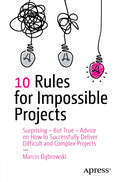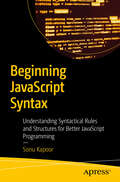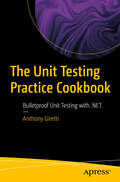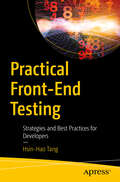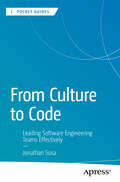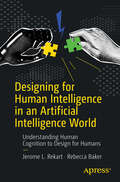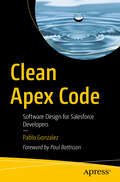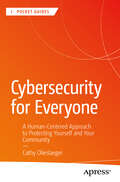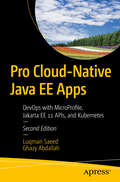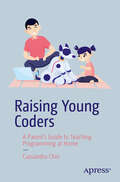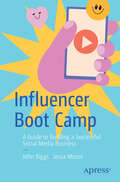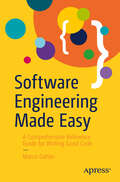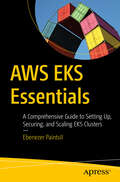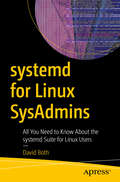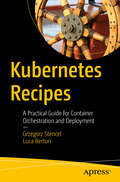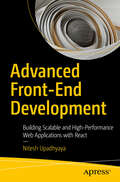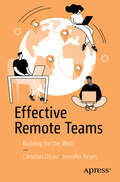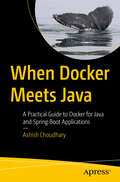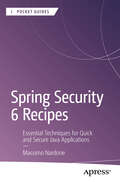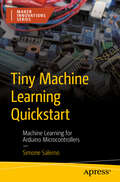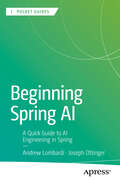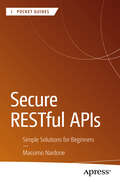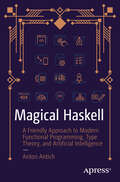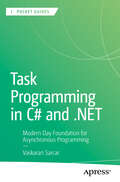- Table View
- List View
10 Rules for Impossible Projects: Surprising – But True – Advice on How to Successfully Deliver Difficult and Complex Projects
by Marcin DąbrowskiThis book is a collection of key principles that should be used to "deliver" difficult and unrealistic projects. These principles are independent of the chosen project management methodology - they remain complementary to them and help to successfully complete even those projects that seem unrealistic: in terms of time, scope, finances and other aspects. These holistic rules cover broad aspects from management, negotiation, psychology and business. It&’s full of real life examples of various international projects which were both successful or failed. The book shows that beyond certifications, methodologies, and manuals, project management professionals need to learn how to face crisis situations, changing scopes and toxic work environments and then successfully deliver a project. What You Will Learn Holistic view on project lifecycle from sales to delivery What is really important for customers in IT projects Key aspects of proactive attitudes needed for successful project delivery Who This Book is For Project Managers, Team Leaders, Unit Managers, IT managers, IT directors, CIOs
Beginning JavaScript Syntax: Understanding Syntactical Rules and Structures for Better JavaScript Programming
by Sonu KapoorThis book is a practical and beginner-friendly guide that focuses exclusively on the syntax of JavaScript, the most widely-used programming language for web development today. Designed to be a clear and accessible introduction for new learners, this book will teach you the essential syntax rules and constructs of JavaScript in a structured, easy-to-understand format. With the explosive growth of web applications and the continued dominance of JavaScript in frameworks like Angular, React, and Node.js, learning JavaScript has never been more relevant. For those starting out in web development, this book will provide the essential foundation needed to build more advanced skills. While other beginner guides may try to cover too much too quickly, this book deliberately focuses on core syntax, so you build a solid understanding from the ground up. Understanding syntax is the first step toward becoming a proficient programmer. JavaScript, in particular, is a flexible yet quirky language with its own unique syntax and conventions. For beginners, this can be overwhelming, but this book demystifies the language&’s structure and explains how to use JavaScript's syntax to write effective and efficient code. Mastery of syntax is critical for writing clean, readable code, and for avoiding common programming errors. The book covers a range of foundational topics, from understanding basic syntax elements like variables, operators, and data types, to mastering control flow with conditionals and loops, and working with more complex structures like functions, objects, and arrays. It also introduces the modern ES6+ syntax features that are now standard in most JavaScript projects, such as arrow functions, destructuring, and template literals. By the end of this book, you will not only have a strong grasp of JavaScript&’s syntax, but also the confidence to write, debug, and maintain your own JavaScript code effectively. Whether you&’re an aspiring developer or someone looking to solidify their understanding of JavaScript&’s building blocks, this book will serve as a valuable resource in your journey. You Will Learn: How to use JavaScript&’s core syntax elements, including variables, data types, operators, control flow (conditionals and loops), and functions. Techniques to debug common JavaScript errors and write clean, readable code How to use key ES6+ syntax features such as arrow functions, template literals, destructuring assignments, and the spread/rest operators How to manipulate the DOM, handle user interactions, and manage data This book is for: Web developers, students, or professionals transitioning into the tech industry
The Unit Testing Practice Cookbook: Bulletproof Unit Testing with .NET
by Anthony GirettiMaster unit testing with the .NET framework by observing examples of best practices. After reading this book, you will feel confident and prepared to approach most situations that a developer will encounter on .NET and ASP.NET Core applications. Learn the best tools to practice effective unit testing, how to architect your code so that it is easily testable, and improve your code coverage. This book is packed with concrete case studies selected from the real-world experiences of a veteran developer, especially when it comes to legacy code. After reading The Unit Testing Practice Cookbook, you will be able to approach unit testing with confidence and make your .NET applications as reliable as possible. What You Will Learn Master unit testing practice Architect your applications efficiently to make your code easily testable Use the best tools for unit testing Automate your unit tests Who This Book is For This book is intended for any developer level wishing to master unit tests with the Microsoft .NET Framework.
Practical Front-End Testing: Strategies and Best Practices for Developers
by Hsin-Hao TangIn the fast-paced and ever-evolving field of front-end development, one of the biggest challenges is maintaining high-quality code while producing work rapidly. This is why testing has become crucial. Deciding on the right testing approach and how to write and execute tests is a key issue every developer must consider. Code without tests is difficult to guarantee in terms of quality, and the solution lies in developing a solid testing strategy. This book provides practical guidance in front-end testing that will help you master a variety of techniques and understand how to apply them in real-world applications. This book dives deep into the types and implementation of front-end testing to teach you best practices for building flexible, maintainable test code. By guiding you through various strategies, the book will help you produce test code efficiently. Its pragmatic approach promises to be useful if you encounter challenges when writing tests and are searching for solutions. The book provides detailed explanations supported by visuals and code examples, helping you learn, practice, and apply various front-end tests. It presents clear principles and approaches to guide you in evaluating testing strategies and costs, so you can make the best choices. Additionally, the book contains thorough explanations of various challenges through easy-to-understand examples, enabling you to tackle testing obstacles with ease. It begins with the fundamentals of testing, discussing basics like types of tests and naming conventions. The subsequent chapters cover how to write and use unit testing, integration testing, end-to-end testing, and visual testing. Additionally, the book includes a chapter on how to perform these tests. The final chapters focus on frequently asked questions about front-end testing, serving as a quick reference for developers. The book concludes with material on how to use AI in testing to boost productivity. You Will Learn: How to write and employ a wide variety of tests, including unit testing, integration testing, end-to-end testing, and visual testing Effectively using AI tools to generate test code and enhance productivity Make informed decisions in testing, based on both cost and effectiveness Who Is This Book For: Front-end developers, full-stack developers, software testers, and QA automation developers.
From Culture to Code: Leading Software Engineering Teams Effectively (Apress Pocket Guides)
by Jonathan SosaThis book is a comprehensive guide written for software engineering professionals who are, or aspire to be, in leadership positions. It begins with essential soft skills, teaching you how to build an influential presence, make confident decisions, guide teams through challenges, and inspire excellence by setting high standards. It continues with sections on acquiring talent, managing, and supporting your team. Learn to write job descriptions that attract top talent, set up a smooth hiring pipeline, and seamlessly onboard new hires. Discover how to structure teams to minimize cognitive load and foster collaboration. Gain actionable insights into goal-setting, including defining OKRs, tracking progress, setting clear expectations, and conducting meaningful evaluations to recognize top performers and support growth. In the final section, the book delves into the technical aspects of leadership. Explore how to choose the right tech stack, establish coding standards, and manage technical debt effectively. Additional chapters offer guidance on evaluating Agile practices, setting clear communication protocols, and balancing quality with delivery speed. Also packed with technical actionable advice from two decades of real-world experience, this book equips you to lead with confidence and drive impactful results. What You Will Learn - How to transition from individual contributor to a leadership position - How to develop your presence, influence, and make difficult decisions - How to craft attractive job descriptions, identify, interview, and hire top talent - How to set expectations, evaluate performance, and promote deserving employees - How to deliver effective feedback - What best practices to introduce to your teams - How to deliver high-quality, impactful software projects Who This Book is For Senior Engineering Managers, Director of Engineering, VP of Engineering, and CTOs. And software engineering professionals who aspire to be in these positions.
Designing for Human Intelligence in an Artificial Intelligence World: Understanding Human Cognition to Design for Humans
by Rebecca Baker Jerome L. RekartHow we think and react has a direct impact on experience design, but often designers don't understand the "whys" behind their best practices, leaving them at risk for misusing or underutilizing those designs. Similarly, psychologists/neuroscientists don't understand the design decisions that their science is informing and how they might be leveraged further. This book explores how neuroscience and cognitive psychology inform experience design, within the modern context of research and technological advances. With a conversational and playful tone, this book begins by grounding you in research and AI. That foundation then allows you to expand your repertoire through chapters on design-relevant cognitive phenomena such as memory, learning, and perception. By delving into how our brains handle these processes and how our designs can effectively (or ineffectively) leverage them, the book follows a journey that weaves academic learning with practical, real-world applications and examples. With the widespread availability of generative AI tools, understanding the intersection of human cognition and design and how that knowledge can be used to build a bridge between the brain and the software has become even more critical. By understanding the brain and human behavior more completely, designers will be able to effectively use AI as an accelerator for tactical projects and provide the context that is unique to the human ability to understand the "why.&”
Clean Apex Code: Software Design for Salesforce Developers
by Pablo GonzalezMany developers excel at building solutions in Apex but lack formal training in the core principles of professional software engineering. This book changes that and provides a no-nonsense guide for experienced Salesforce developers ready to master the art of software design. Pragmatic, approachable, and to the point, this book focuses on essential practices like modularity, coupling, cohesion, and testing—not just to write better code, but to improve how teams deliver software. By emphasizing object-oriented programming, dependency injection, and boundaries, it equips you to design systems that are easier to maintain, test, and scale. With fast, reliable tests as a cornerstone, you&’ll learn how great design enables true continuous integration and high-performance software delivery. Through actionable examples and clear explanations, you&’ll learn how to design better systems, reduce complexity, and create codebases that stand the test of time. If you&’re serious about your craft, Clean Apex Code will give you the tools and mindset to think like a professional software engineer and deliver software at a higher level. What You Will Learn Use better names in all software constructs to improve readability and maintainability Apply core software design principles to Apex development Embrace modularity, abstraction, and boundaries to simplify complex systems Leverage dependency injection, and mocking to write fast, modular tests <li class="MsoNormal" style="mso-margin-top-alt: auto; mso-margin-bottom-alt: auto; line-height: normal; mso-list: l0 level1 lf
Cybersecurity for Everyone: A Human-Centered Approach to Protecting Yourself and Your Community (Apress Pocket Guides)
by Cathy OlieslaegerIn a world where cyber threats are growing exponentially in number and complexity, it&’s time to ask the tough question: What are we doing wrong? We&’ve been tackling cybersecurity the same way for years, yet the bad actors continue to stay ahead. Financial losses mount, and the talent gap in the cybersecurity industry remains a persistent challenge. It&’s time to break the cycle. This book takes a bold, fresh look at cybersecurity by shifting the focus away from the technical jargon and putting the spotlight on the people who matter most—you. Whether you&’re a student, a professional, a parent, or a business leader, this book is designed to help you understand cybersecurity&’s role in everyday life and how you can make a difference. From the classroom to the boardroom, there&’s a shared responsibility in keeping our digital world safe. Unlike traditional cybersecurity books filled with complex terminology and tech-heavy concepts, this book humanizes the topic. It provides practical, real-world solutions for protecting yourself, your family, your workplace, and your community. You&’ll learn not just the how but also the why—why cybersecurity matters and why it's a people-first issue that concerns all of us, regardless of our background or profession. Whether you&’re just starting your cybersecurity journey or you're looking to build a security-first culture within your organization, this book equips you with the knowledge and confidence to make an impact. With a focus on democratizing cybersecurity knowledge, this guide is your call to action, offering accessible insights to foster a more secure digital future for everyone. What You Will Learn Protect yourself and the people you care about Journey into cybersecurity without having to break anything Educate students about keeping safe in the digital world Build bridges between the educational and professional worlds Establish a cybersecurity cultrure as a bsiness leader Who This Book Is For Whether you&’re a student, professional, parent, or business leader, this book is designed to help you understand cybersecurity&’s role in everyday life and how you can make a difference. From the classroom to the boardroom, there&’s a shared responsibility in keeping our digital world safe.
Pro Cloud-Native Java EE Apps: DevOps with MicroProfile, Jakarta EE 11 APIs, and Kubernetes
by Luqman Saeed Ghazy AbdallahLearn how to build and deploy Java-based cloud native apps with Jakarta EE with the MicroProfile framework and Kubernetes. This revamped Second Edition reflects the latest updates in Jakarta EE 11, including enhanced support for creating web APIs with Jakarta REST, concurrency management with Jakarta Concurrency, and data persistence with Jakarta Persistence, while incorporating key changes introduced by MicroProfile 7.0. After a quick overview of Jakarta EE and MicroProfile, Pro Cloud Native Java EE Apps starts you on your way by walking you through a cloud-native Jakarta EE-based application case study that will be forged piece-by-piece over the course of the book. Next, you'll interject dependencies and data persistence capabilities as microservices to go with the case study app that you are building. Then, you will dive into migrating a monolith to become a production-ready cloud-native app. Finally, you will look ahead to the future of Jakarta EE with a NEW chapter on artificial intelligence and large language models, exploring potential use cases for how AI-integration can enhance Jakarta EE capabilities. This revised new edition ensures you are equipped with the most current tools and techniques to develop forward-looking, cloud-native apps. What You Will Learn ● Build and deploy a production-ready cloud-native Java app using MicroProfile, Jakarta EE and Kubernetes ● Migrate a monolith app to become a cloud-native app ● Employ Jakarta EE APIs such as Persistence, CDI and more ●<span style="font: 7.0pt '
Raising Young Coders: A Parent’s Guide to Teaching Programming at Home
by Cassandra ChinIntroduce your children to programming at an early age and see how nurturing their interest can significantly contribute to their future success. This book offers creative, kid-friendly tools and projects to ignite childhood curiosity, all while confronting early-age gender biases in tech and supplementing the lack of creative and diverse tech curriculum in schools. Parents will explore a range of fun technology projects to share with their kids, sorted by difficulty, suitable for pre-K through pre-teen ages. For example, the Squishy Circuits project shows early learners how to connect wires to play dough to make LED lights shine. Meanwhile, the block-coding project encourages kids to drag and drop code blocks to control a robot that they get to build. For more advanced projects, young coders will explore a Raspberry Pi workshop, involving hardware wiring and writing the code that brings their creation to life. The projects are designed so that parents and kids can pick and choose activities based on interest level. For further inspiration, Raising Young Coders wraps up by showcasing interviews with successful women in technology. These role models recount early childhood experiences learning technology with their parents. The stories will motivate kids and parents to engage with technology together, recognizing its pivotal role as a cornerstone for an array of future opportunities. What You Will Learn Understand why it is important to inspire your kids to want to learn technology. <span lang="EN-IN" style="font-size: 12.0pt; mso-ascii-font-family: Calibri; mso-fareast-font-family: 'Times New Roman
Influencer Boot Camp: A Guide to Building a Successful Social Media Business
by John Biggs Jessa MooreLearn how to leverage your own social media through techniques used by influencer agencies and successful digital marketers. Influencer marketing can amplify word of mouth and reputation to energize your own community. This book traces the history of influencer marketing, highlighting key milestones and shifts in consumer preferences. It guides readers on discovering their unique niche within the influencer space, emphasizing the importance of authenticity and passion. It shows you strategies for developing a strong personal brand that resonates with your target audience and sets you apart from competitors. It shares practical tips and techniques for creating compelling content across various platforms, including visual storytelling, copywriting, and video production. Through this book, you will learn techniques to communicate your story, manage your reputation, and grow your own influence.
Software Engineering Made Easy: A Comprehensive Reference Guide for Writing Good Code
by Marco GählerLearn how to write good code for humans. This user-friendly book is a comprehensive guide to writing clear and bug-free code. It integrates established programming principles and outlines expert-driven rules to prevent you from over-complicating your code. You&’ll take a practical approach to programming, applicable to any programming language and explore useful advice and concrete examples in a concise and compact form. Sections on Single Responsibility Principle, naming, levels of abstraction, testing, logic (if/else), interfaces, and more, reinforce how to effectively write low-complexity code. While many of the principles addressed in this book are well-established, it offers you a single resource. Software Engineering Made Easy modernizes classic software programming principles with quick tips relevant to real-world applications. Most importantly, it is written with a keen awareness of how humans think. The end-result is human-readable code that improves maintenance, collaboration, and debugging—critical for software engineers working together to make purposeful impacts in the world. What You Will Learn Understand the essence of software engineering. Simplify your code using expert techniques across multiple languages. See how to structure classes. Manage the complexity of your code by using level abstractions. Review test functions and explore various types of testing. Who This Book Is For Intermediate programmers who have a basic understanding of coding but are relatively new to the workforce. Applicable to any programming language, but proficiency in C++ or Python is preferred. Advanced programmers may also benefit from learning how to deprogram bad habits and de-complicate their code.
AWS EKS Essentials: A Comprehensive Guide to Setting Up, Securing, and Scaling EKS Clusters
by Ebenezer PaintsilMaster the essential tools of Amazon Elastic Kubernetes Service (EKS) and explore the various architecture options. This book offers a deep dive into setting up, managing, and scaling your Kubernetes clusters on AWS. You&’ll start by exploring various architecture options, including private-only, public and hybrid endpoint configuration alternatives. The focus then shifts to security and cluster implementation with Terraform covering the three cluster configuration alternatives, role assignments, node security, and more. The book also dives into pod density providing practical demonstrations of IP address management in EKS and shows you how to customize cluster node groups with launch templates. Complete your journey by reviewing advanced EKS concepts such as auto scaling Karpenter, service mesh, and application networking with VPC Lattice. With AWS EKS Essentials as your guide, you&’ll maintain robust cluster security and strong access control, ensuring your applications run smoothly and efficiently in a cloud-native environment. What You Will Learn Handle role assignments and node security Secure EKS clusters with private endpoints, security groups and bastion hosts. Run applications in Kubernetes, including Docker Desktop installation Optimize custom container images and manage private repositories Implement service mesh and application networking with AWS App Mesh, Istio, and VPC Lattice Create and deploy EKS clusters with Terraform Who This Book Is For Software developers, system administrators, and cloud enthusiasts who are looking to master EKS.
systemd for Linux SysAdmins: All You Need to Know About the systemd Suite for Linux Users
by David BothExplore the world of systemd—yes, all lower-case, even at the beginning of a sentence— which is the modern replacement for init and SystemV init scripts. It is also much more. It can evoke a wide range of reactions from SysAdmins and others responsible for keeping Linux systems up and running. The fact that systemd is taking over so many tasks in modern Linux systems has engendered push-back and discord among certain groups of developers and SysAdmins. You will learn systemd&’s strengths and weaknesses, and why there&’s no truth in the myth that systemd is a monolithic monstrosity.Learn how systemd is the mother of all processes, and is responsible for bringing the Linux host up to a state in which productive work can be done. You&’ll learn about the functions assumed by systemd, which is far more extensive than the old init program, and how it manages many aspects of a running Linux host, including: Mounting filesystems Managing hardware Creating new systemd services and understanding existing ones Creating timers that trigger system maintenance events Starting and managing the system services that are required to have a productive Linux host Using the systemd journal to access critical performance and problem solving information. Why the systemd plan to take over the world is actually a good thing systemd for Linux SysAdmins is your one-stop shop, giving you everythiing you need to get started and utilize this software suite for Linux operatiing systems. You Will Learn: How to use systemd, what it is, and what it does To manage each of the major functional components of systemd and learn from real-world examples to illustrate their typical usage by SysAdmins Pragmatic work-arounds, hints and tricks to minimize issues to ensure you have greater systemd functionality This Book is for: Linux system administrators (SysAdmins) who need to or are already in the process of switching from SystemV to systemd. It&’s also intended for SysAdmins with more systemd experience but who want to improve their knowledge and skills with systemd.
Kubernetes Recipes: A Practical Guide for Container Orchestration and Deployment
by Luca Berton Grzegorz StencelKubernetes Recipes is your essential guide to using Kubernetes for container orchestration providing a hands-on, problem-solving approach to address the intricacies of deployment, scaling, and day-to-day operations. The book's format, organized for easy lookup, ensures that you can swiftly find detailed solutions to your challenges in your Kubernetes journey. Beginning with the fundamentals, the book covers Kubernetes installation, working with the Kubernetes API, and understanding application primitives for efficient deployment. It teaches monitoring and troubleshooting strategies, providing practical insights into handling issues that may arise in your clusters. Whether new to Kubernetes or seeking advanced insights, the book covers a broad spectrum of topics, including managing specialized workloads, handling volumes and configuration data, implementing scaling strategies, and ensuring security. Kubernetes Recipes is not merely a theoretical guide; it equips you with practical skills for everyday tasks, such as using the Kubernetes client effectively, creating and modifying fundamental workloads, managing services, and exploring the Kubernetes API. It doesn't stop at the basics but extends to advanced areas like developing Kubernetes, monitoring and logging practices, and exploring the ecosystem with tools like Helm. With this comprehensive guide, you not only build a strong foundation in Kubernetes but also gain insights into the intricacies of its ecosystem. Whether you are looking to troubleshoot common issues, implement security measures, or develop applications for Kubernetes, this book is your go-to resource. It provides practical, actionable solutions for every step of learning this industry-leading containerization platform. You will: Learn how to orchestrate cloud-native applications and apply the design to new and existing applications. Acquire practical skills in deploying applications on Kubernetes, covering installations, CLI usage, and local instance management. Learn cluster management techniques using tools, explore diverse creation methods, and deploy on popular cloud platforms. Gain an awareness of the debugging methods and tools available in Kubernetes. Understand how to Implement security best practices, control access, and secure pods while also gaining proficiency in monitoring resources, accessing logs, and handling common troubleshooting scenarios in Kubernetes environments. The Book is for: Developers, System Administrators, DevOps Professionals as well as Project Managers, students and researchers
Advanced Front-End Development: Building Scalable and High-Performance Web Applications with React
by Nitesh UpadhyayaThis book is your comprehensive guide to mastering React, the most popular library for building modern web applications. Designed for developers at all levels, it offers a structured approach to understanding and applying React&’s core and advanced concepts to create responsive, scalable, and high-performance web applications. Starting with the basics, such as components, JSX, and state management, the book gradually progresses to advanced topics like context API, hooks, routing, and performance optimization. Every chapter is enriched with hands-on examples and step-by-step guides to help you solidify your understanding of React&’s ecosystem. The book encourages you to dive deeper into essential best practices, including code maintainability, testing strategies, and leveraging third-party libraries for UI components. It also explores modern state management tools, techniques for optimizing performance, and adopting cutting-edge deployment strategies with platforms like Netlify and Vercel, ensuring that the applications you build are robust and reliable. Beyond just React&’s core concepts, this book emphasizes practical application through a real-world project: building a fully functional e-commerce application. From implementing dynamic product listings to creating a seamless checkout flow with payment gateway integration, you&’ll gain hands-on experience that prepares you for real-world challenges. By the end of this book, you&’ll not only master React but also develop the skills to build, test, and deploy high-quality web applications that meet the demands of today&’s fast-paced development landscape. Whether you&’re a beginner or a seasoned developer, this book will elevate your expertise and help you stay ahead in the evolving world of web development. What You'll Learn: The foundational concepts of React, including JSX, components, and state management. How to use advanced React techniques, such as hooks, context API, performance optimization, and routing. How to create responsive, scalable, and maintainable web applications using modern React libraries and tools. Understand practical approaches to building a real-world e-commerce application, including dynamic product listings, cart functionality, and payment gateway integration Gain expertise in techniques for optimizing performance, testing, and deploying React applications to platforms like Netlify. Who is this book for: Software architects and developers with intermediate knowledge of HTML, CSS, and JavaScript, frontend developers, and full-stack developers
Effective Remote Teams: Building for the Web
by Carleton DiLeo Jennifer ReyesRemote development has drastically changed the way teams build software. The freedom to work from wherever and possibly whenever has increased flexibility, but these benefits have not come without growing pains. The people managing this new type of team have worked tirelessly to adapt existing practices to this new, unfamiliar environment. The good news is you don’t have to go through it alone. Authors Carleton DiLeo and Jennifer Reyes draw from two decades of combined experience building and managing highly-effective remote teams. You’ll see how to set up, manage, and maintain your team. These ideas have been tested, boiled down, and refined over the years into an easy-to-understand series of steps. If you want to build a new remote team or transition from in-person, Effective Remote Teams has you covered. Read on to start enjoying the benefits of remote development today. What You Will Learn Build an ecosystem to promote collaboration and automation Create an onboarding process to get new team members quickly integrated Manage an ideal work week Use the “strike team” method to structure your team Make changes to your team and process without affecting velocity Keep your team happy and productive long-term Who This Book is For Managers, team leaders, and startup founders
When Docker Meets Java: A Practical Guide to Docker for Java and Spring Boot Applications
by Ashish ChoudharyDiscover how to become a more efficient Java developer using Docker. This book will help you streamline your development process, boost portability, and enhance the efficiency of your applications. Docker has transformed the landscape of application and deployment by simplifying the creation and management of development environments, saving valuable time and reducing compatibility issues. With this book, you will learn how to package Java applications into Docker containers, making them consistent and portable across different environments. As a result, you’ll gain the expertise to efficiently scale and manage your applications, ensuring they run smoothly in production to boost development efficiency. This book sets itself apart through its emphasis on Java developers’ specific needs and challenges, providing relevant examples and use cases. The hands-on practical approach provides you with the necessary skills to be a more valuable Java developer. What You Will Learn Understand the fundamental concepts of Docker and containerization Package Java applications into Docker containers Gain hands-on experience in Dockerizing Java applications Efficiently test, debug, deploy, and scale Java applications using Docker Acquire skills that will make you a more valuable and efficient Java developer Who This Book Is For Java developers who want to make their applications more portable and easier to manage
Spring Security 6 Recipes: Essential Techniques for Quick and Secure Java Applications (Apress Pocket Guides)
by Massimo NardoneEnsure robust web security for your Java applications in just a few days. This recipe-driven, practical pocketbook provides a straightforward guide to quickly developing and deploying secure enterprise applications using the Spring 6 Framework, Spring Boot 3, and the H2 database. The book is organized into problems and corresponding recipes, offering solutions for both small and large challenges. First, you will learn how to install all essential development tools, such as IntelliJ IDEA, JDK v17, and Maven. Then you will dive into recipes on using Spring Security 6 with JSP tags and Thymeleaf and integrating security features through Spring Boot 3 Initializr. Finally, you'll be equipped to build your own Spring Boot project using Spring Security, Spring Data JDBC, and the H2 database. This recipes guide is ideal for readers who want to get up and running with only the essential security features in a fraction of time. Its simplified approach offers immediate results for securing Java applications. What You Will Learn Set up and configure Spring Security 6 installation tools Explore the basics of integrating Spring Security 6 with JSP tags, Thymeleaf, and Spring Boot 3 Initializr Build and deploy a secure Spring Boot application using Spring Data JDBC and the H2 database Who This Book Is For Beginners in Spring Security 6, Boot 3 Initializr, and H2 DB, and assumes you have some basic web development and security experience. It is suitable for busy readers who are seeking a simple, focused approach for immediate results. For more comprehensive coverage, detailed explanations, and advanced topics, we recommend Pro Spring Security: Securing Spring Framework 6 and Boot 3-based Java Applications.
Tiny Machine Learning Quickstart: Machine Learning for Arduino Microcontrollers (Maker Innovations Series)
by Simone SalernoBe a part of the Tiny Machine Learning (TinyML) revolution in the ever-growing world of IoT. This book examines the concepts, workflows, and tools needed to make your projects smarter, all within the Arduino platform. You’ll start by exploring Machine learning in the context of embedded, resource-constrained devices as opposed to your powerful, gigabyte-RAM computer. You’ll review the unique challenges it poses, but also the limitless possibilities it opens. Next, you’ll work through nine projects that encompass different data types (tabular, time series, audio and images) and tasks (classification and regression). Each project comes with tips and tricks to collect, load, plot and analyse each type of data. Throughout the book, you’ll apply three different approaches to TinyML: traditional algorithms (Decision Tree, Logistic Regression, SVM), Edge Impulse (a no-code online tools), and TensorFlow for Microcontrollers. Each has its strengths and weaknesses, and you will learn how to choose the most appropriate for your use case. TinyML Quickstart will provide a solid reference for all your future projects with minimal cost and effort. What You Will Learn Navigate embedded ML challenges Integrate Python with Arduino for seamless data processing Implement ML algorithms Harness the power of Tensorflow for artificial neural networks Leverage no-code tools like Edge Impulse Execute real-world projects Who This Book Is For Electronics hobbyists and developers with a basic understanding of Tensorflow, ML in Python, and Arduino-based programming looking to apply that knowledge with microcontrollers. Previous experience with C++ is helpful but not required.
Beginning Spring AI: A Quick Guide to AI Engineering in Spring (Apress Pocket Guides)
by Andrew Lombardi Joseph OttingerDiscover how to use Large Language Models in the Spring Framework. This quick guide equips developers with insights into the strengths and limitations of Spring AI and how to leverage the model for typical use cases. First, you will orient yourself to the new and exciting landscape of AI and Spring integration. You will learn how to issue simple queries, asking the right questions to get the results you want. From there, you will be empowered to select the right model for functionality and refinement, building a simple yet effective chat bot using real-world examples. Additionally, the book explores how to generate images, refine them, and how to send source images when appropriate. Lastly, the book focuses on how Spring AI and LLMs affect the developer landscape, including pitfalls and ethical concerns. Designed for fast adoption, this book provides targeted guidance on integrating AI and LLMs into your projects within days. Through a pragmatic approach, it emphasizes direct utilization of the API. What You Will Learn Explore popular use cases for LLMs Gain insight into the Spring AI module, including its capabilities and limitations Know how to create effective queries and interactions for AI-driven conversations and image generation Discover strategies for selecting an appropriate LLM service and model Acquire skills to AI-proof your job and understand why it is NOT a replacement What This Book Is Spring developers who are new to AI and focused on the essentials without exhaustive framework details. This is an optional supplement to the more comprehensive Apress book, Beginning Spring 6.
96 Common Challenges in Power Query: Practical Solutions for Mastering Data Transformation in Excel and Power BI
by Omid MotamedisedehThis comprehensive guide is designed to address the most frequent and challenging issues faced by users of Power Query, a powerful data transformation tool integrated into Excel, Power BI, and Microsoft Azure. By tackling 96 real-world problems with practical, step-by-step solutions, this book is an essential resource for data analysts, Excel enthusiasts, and Power BI professionals. It aims to enhance your data transformation skills and improve efficiency in handling complex data sets. Structured into 12 chapters, the book covers specific areas of Power Query such as data extraction, referencing, column splitting and merging, sorting and filtering, and pivoting and unpivoting tables. You will learn to combine data from Excel files with varying column names, handle multi-row headers, perform advanced filtering, and manage missing values using techniques such as linear interpolation and K-nearest neighbors (K-NN) imputation. The book also dives into advanced Power Query functions such as Table.Group, List.Accumulate, and List.Generate, explored through practical examples such as calculating running totals and implementing complex grouping and iterative processes. Additionally, it covers crucial topics such as error-handling strategies, custom function creation, and the integration of Python and R with Power Query. In addition to providing explanations on the use of functions and the M language for solving real-world challenges, this book discusses optimization techniques for data cleaning processes and improving computational speed. It also compares the execution time of functions across different patterns and proposes the optimal approach based on these comparisons. In today’s data-driven world, mastering Power Query is crucial for accurate and efficient data processing. But as data complexity grows, so do the challenges and pitfalls that users face. This book serves as your guide through the noise and your key to unlocking the full potential of Power Query. You’ll quickly learn to navigate and resolve common issues, enabling you to transform raw data into actionable insights with confidence and precision. What You Will Learn Master data extraction and transformation techniques for various Excel file structures Apply advanced filtering, sorting, and grouping methods to organize and analyze data Leverage powerful functions such as Table.Group, List.Accumulate, and List.Generate for complex transformations Optimize queries to execute faster Create and utilize custom functions to handle iterative processes and advanced list transformation Implement effective error-handling strategies, including removing erroneous rows and extracting error reasons Customize Power Query solutions to meet specific business needs and share custom functions across files Who This Book Is For Aspiring and developing data professionals using Power Query in Excel or Power BI who seek practical solutions to enhance their skills and streamline complex data transformation workflows
Secure RESTful APIs: Simple Solutions for Beginners (Apress Pocket Guides)
by Massimo NardoneSecure your RESTful APIs with confidence and efficiency. This straightforward guide outlines the essential strategies and best practices for protecting sensitive data when developing RESTful APIs for your applications. Inside, you’ll explore the fundamental functionalities to implement industry-standard authentication authorization mechanisms for Java applications. With chapters covering key security concerns, data protection, and designing and testing secure APIs, this book provides a hands-on approach to protecting user data, validating inputs, and implementing security mechanisms such as JSON Web Tokens (JWT) and OAuth2 authentication. This book offers a focused introduction without unnecessary complexity. Whether you are a beginner or busy professional, this is the only book designed to help you secure your RESTful APIs in no time. What You Will Learn Understand the fundamentals of RESTful APIs and why it is critical to secure them Identify common security risks concerning RESTful APIs and explore effective protection techniques Know how to design and test RESTful APIs, including with input and response data validation Review examples of how to secure JSON Web Token (JWT) and OAuth3 with RestFUL APIs Who This Book is For Web developer beginners who want to learn how to develop Security RESTful APIs applications
Magical Haskell: A Friendly Approach to Modern Functional Programming, Type Theory, and Artificial Intelligence
by Anton AntichDiscover a unique and fun approach to adopting modern typed functions programming patterns. This book uses playful metaphors and examples to help you learn Haskell through imagination, building on math without relying on imperative crutches or technical complexity. You’ll use math to build completely different Typed Functional patterns from the ground up and understand the link between building Mathematics through Types and constructing Haskell as a programming language. Intended for working with various applications, especially AI-powered apps, the book gently builds up to what are normally considered complex and difficult concepts all without needing a PhD to understand them. Illustrative explanations will guide you to tackle monads, using monad transformer stacks to structure real programs, foldable and traversable structures, as well as other Type classes. This book will also help you structure programs efficiently and apply your own abstractions to real-life problem domains. Next, you’ll explore exciting advancements in AI, including building with OpenAI APIs, creating a terminal chatbot, adding web functionality, and enhancing with retrieval-augmented generation. Finally, you’ll delve into AI multi-agents and future directions using Arrows abstraction, reinforcing Haskell’s design. Magical Haskell is a solution for programmers who feel limited by imperative programming languages but are also put off by excessively mathematical approaches. What You Will Learn Grasp a solid math foundation without complex technicalities for Types and Typeclasses. Solve problems via a typed functional approach and understand why it’s superior to what’s available in the imperative language world (“if it compiles, it runs”). Build your own abstractions to efficiently resolve problems in any given domain. Develop AI frameworks in Haskell, including chatbots, web functionality, and retrieval-augmented generation. Who This Book Is For Haskell programmers of all levels and those interested in Type Theory.
Task Programming in C# and .NET: Modern Day Foundation for Asynchronous Programming (Apress Pocket Guides)
by Vaskaran SarcarAt a high level, to understand asynchronous programming, you need to be familiar with task programming, efficient use of the async and await keywords, and a few more important topics. However, task programming is the first major step towards modern-day asynchronous programming. This book tries to simplify the topic with simple examples, Q&A sessions, and exercises The book starts with an introduction to asynchronous programming and covers task creation and execution. Next, you will learn how to work with continuing and nested tasks. Next, it demonstrates exception handling with different scenarios. Towards the end, you will understand how to manage task cancellations through examples and case studies. After reading this book, you can write efficient codes for multithreaded, asynchronous, and parallel development in C#. What You Will Learn: Dig deep into task programming which is an essential part of the concurrent and multithreaded developments. Learn modern-day C# features that are foundations of asynchronous programming How the advanced features in C# such as delegates, lambdas, generics, etc. can be used in concurrency Who This Book is For: C# and .NET developers
